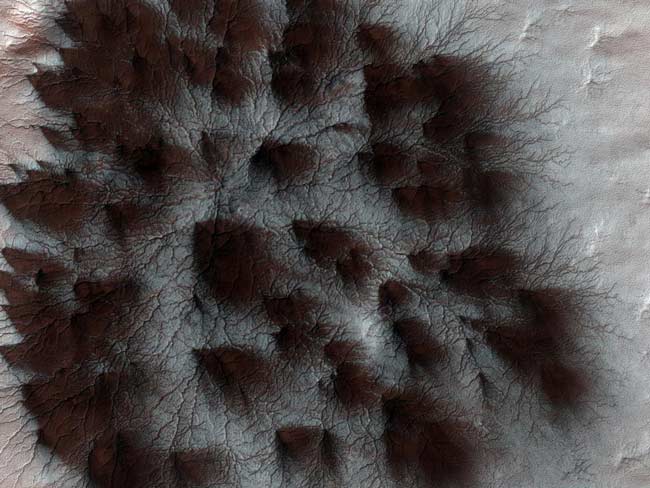Signs of Spring on Mars

A Martian orbiter has spotted seasonal footprints ofspring creeping up on the red planet.
Seasonal polar caps formed from carbon dioxide have begunvaporizing or changing directly from solid ice to gas, and have kicked off achain of events detected by NASA's MarsReconnaissance Orbiter (MRO).
"Spring on Mars is quite different from spring onEarth because Mars has not just permanent ice caps, but also seasonal polarcaps of carbon dioxide, familiar to us on Earth as dry ice," said CandiceHansen-Koharcheck, an MRO scientist at the NASA Jet Propulsion Laboratory inPasadena, Calif.
Ice caps form each Martian winter as carbon dioxidechanges directly to frost and builds dry ice layers more than three feet thick.The arrival of warmer spring temperatures thaws the solid carbon dioxide andthins the ice cap from both top and bottom.
The carbon dioxide gas beneaththe ice cap often flows in the same places each year, eventually creatingchannels or troughs in the planet's surface. MRO has spotted many such spiderynetworks of cracks that remain even after the ice caps have vanished.
Pressure from the newly thawed gas also builds up beneaththe thinning ice cap, which can lead to puffs of escaping gas and dust wherethe ice cap has cracked.
"What happens on Mars, we think, is that as theseasonal ice cap thins from the bottom, gas underneath the cap builds uppressure," Hansen-Koharcheck said. "And where gas under the ice findsa weak spot or a crack, it will flow out of the opening, often carrying alittle dust from the surface below."
Get the Space.com Newsletter
Breaking space news, the latest updates on rocket launches, skywatching events and more!
That dust ends up swirling about in the wind beforesettling in fan-like or starburst patterns, pointingin the direction of the prevailing wind at the time. Each patternrepresents a jet of gas that was active at one time.
The Martian process differs from springtime thaws onEarth, where frozen water melts from solid to liquid and becomes runoff. Scientistshave yet to spot flowing water on the Martian surface, though some suspectliquids may lie beneath the surface or even insidea volcano.
- Video - Mars Reconnaissance Orbiter
- Phoenix Mars Lander: Digging for Secrets of the Martian Arctic
- Video - Digging on Mars
Join our Space Forums to keep talking space on the latest missions, night sky and more! And if you have a news tip, correction or comment, let us know at: community@space.com.

Space.com is the premier source of space exploration, innovation and astronomy news, chronicling (and celebrating) humanity's ongoing expansion across the final frontier. Originally founded in 1999, Space.com is, and always has been, the passion of writers and editors who are space fans and also trained journalists. Our current news team consists of Editor-in-Chief Tariq Malik; Editor Hanneke Weitering, Senior Space Writer Mike Wall; Senior Writer Meghan Bartels; Senior Writer Chelsea Gohd, Senior Writer Tereza Pultarova and Staff Writer Alexander Cox, focusing on e-commerce. Senior Producer Steve Spaleta oversees our space videos, with Diana Whitcroft as our Social Media Editor.









